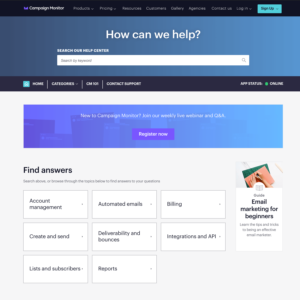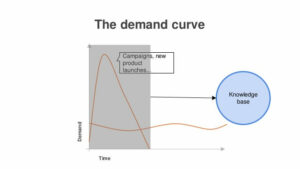Keen to know more
about our Full Service?
Our world class qualitative user testing can help explain the why behind your data and give you the answers to your burning questions.
“Thank you for calling, please hold while we connect you.” Cue elevator music. Wait. Wait. Wait some more. Sounds painfully familiar, doesn’t it? I think everyone has had a bad experience with customer support before, but it doesn’t have to be this way, and TestMate can help!
Organisations today from Financial Institutions to Government Agencies are leveraging a new type of customer service designed to answer the needs of their users as efficiently as possible and without the need for human assistance. Customer self-service is the next frontier in quality support services as organisations look to offer a complete customer experience, from the moment you purchase to when you need help. In fact, Harvard Business Review’s data shows that 81% of customers try to take care of a problem themselves before reaching out to a representative. But don’t expect to see call centre volume decrease just because you put up a new FAQ page on your website. Learn about the benefits of customer self-service, how you can meet user expectations and increase self-service adoption in this digital transformation era.
Self-service vs. Assisted service
Providing traditional assisted service can be costly, which is one of
the reasons why customer self service is becoming increasingly
popular. As problems become more technical, the more expertise and training required to solve them. Also, long waits for live calls and delayed response times for email and snail mail support add to the frustration for consumers, an issue that is not faced when using the online adoption of user self service. Support should be fast, easy, and effective. That’s why organisations are looking towards customer self-service as the future. However, the idea of customer digital adoption and self-service isn’t new. From the first ATM to kiosks in airports that help you with everything from checking in to bag-tagging, we have continued to look for ways to let consumers solve problems and complete tasks without assistance from a rep. In today’s digital world, customer self-service has taken the form of online self service platforms. A customer self-service platform can range from an app, chatbot, and website knowledge bases: all designed to allow the customer to solve their issues from the first interaction.
Digital Transformation Era
If self-service isn’t new, why is it important now? The answer is digital transformation. We live in an age where companies like Uber can be the world’s largest taxi company but own no vehicles. Companies and organisations, from governments to banks to retail, are fundamentally transforming their business models to look more like digital age companies. Traditional businesses and organisations have now adopted a scalable approach, which means that customer support services need to be scalable too. As a result, we have seen increased adoption of knowledge bases and AI tools over assisted service methods to provide solutions for consumers that scale with business operations. With the digital world progressing more and more every day, online customer self-service systems are too becoming increasingly popular. Online self service can mean dramatically lower overhead costs as well as higher levels of convenience for both the consumer and the retailer.
Knowledge Base
There are three main types of requests that users typically need support for: get more information, get stuff done, and solve problems. The easiest request to solve effectively through customer self-service is getting more information. A knowledge base is a section of your website where users can find answers for common product issues or simple support questions. This allows organisations to provide high-level support to users as they troubleshoot their problems themselves. The key to creating an effective knowledge base is to offer intuitive navigation and a consistent brand voice. Support should feel like a seamless part of your organisation, therefore maintaining your brand’s voice throughout all content you create, from marketing to support, is integral to providing the experience that your customers expect. 65% of customers want their problem resolved the first time, so your navigation needs to be easy to use so that your users can find the answers they need without hassle.
 Campaign Monitor is an example of a company who leverages its knowledge base to help users find answers fast. Its layout is simple and to the point, either allowing you to search directly for a resolution or pick from their most common issue categories. In addition, their knowledge base includes an “app status” feature that connects users directly to its status page when there is a widespread issue.
Campaign Monitor is an example of a company who leverages its knowledge base to help users find answers fast. Its layout is simple and to the point, either allowing you to search directly for a resolution or pick from their most common issue categories. In addition, their knowledge base includes an “app status” feature that connects users directly to its status page when there is a widespread issue.
Chatbots
Another trend in self-service is chatbots. Automation in service is great because it makes the lives of the user and rep easier. Customers can utilise chatbots to get answers without having to ever pick up the phone. However, not all chatbots are useful. To be effective, an AI chatbot needs to allow users to select guided options with ease as well as allow for free-form input. Consumers of today demand choice, so it is imperative that your chatbot can go beyond strict pre-programmed paths and answer questions naturally. If your chatbot only allows you to get answers for a few pre-determined questions, it isn’t much better than a FAQ page. On the flip side, if the user requires further support from an agent, escalation from the chatbot to your service rep should be integrated into your service. Consumers want easy access across all channels of support, and when the first contact point fails it is important to make that transition as pain-free as possible.
Effortless resolution
 The key to increasing customer satisfaction with your support services is about providing an effortless solution. What this means in practice is that you have to fully understand your user’s needs to effectively solve them. Your support services should mirror demand. Demand for support is highest with new product launches, updates, and campaigns. Therefore, your knowledge base should answer the most common questions and issues first, with an emphasis on new products and updates that need the most support.
The key to increasing customer satisfaction with your support services is about providing an effortless solution. What this means in practice is that you have to fully understand your user’s needs to effectively solve them. Your support services should mirror demand. Demand for support is highest with new product launches, updates, and campaigns. Therefore, your knowledge base should answer the most common questions and issues first, with an emphasis on new products and updates that need the most support.
Keep improving
Self-service can’t be set and forgotten, it should always be a work in progress. Back up your customer self-service interfaces with usability tests to ensure that your users can effectively navigate and resolve their issues in as few contact points as possible. Continue to update your knowledge base content to match the demands of your users, specifically generating new content for new updates and products that your users will need the most help with. By adopting a focus on the user, you can work to match their expectations and provide the solutions they need without the help of assisted services.Computer security software company McAfee managed to cut their support calls by 90% as a result of a user interface redesign. The future of support services is digital and scalable.
Looking to increase your focus on customer satisfaction? Do you want to reduce customer call center costs? TestMate can help you learn how! Reach out to us to get invaluable insight into improving your UX.

Our world class qualitative user testing can help explain the why behind your data and give you the answers to your burning questions.